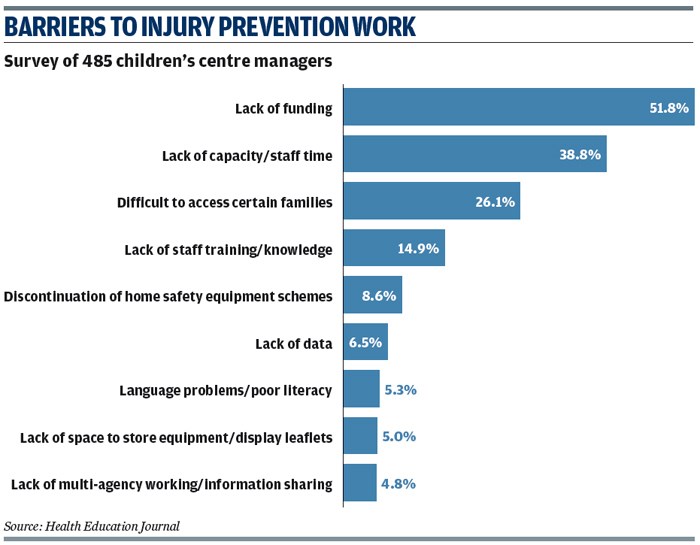Research Report: National Survey of Injury Prevention Activities of Children's Centres
Charlotte Goddard
Tuesday, April 26, 2016
There is a lot of research into the role children's centres play in improving outcomes for disadvantaged families. However, researchers from the University of Nottingham were keen to investigate centres' role in preventing injuries to under-fives, an area not previously analysed. Previous research has found injuries disproportionately affect children from low-income families.
Authors Michael Watson, Caroline Mulvaney, Clare Timblin, Jane Stewart, Carol Coupland, Toity Deave, Mike Hayes and Denise Kendrick
Published by Health Education Journal, February 2016
Summary
The researchers surveyed 485 children’s centre managers for their paper Missed Opportunities to Keep Children Safe? National Survey of Injury Prevention Activities of Children’s Centres. Almost all respondents – 98.2 per cent – agreed or strongly agreed children’s centres can be effective in preventing accidents.
More children’s centres did not have a written child injury prevention strategy than those that did – 47.4 per cent compared with 42.3 per cent. The majority of respondents did not know if their local authority or health service commissioner had a child injury prevention strategy.
Children’s centre managers showed a poor knowledge of the main cause of child injury deaths in the under-fives in the home with only 11.7 per cent of respondents correctly identifying choking and suffocation. Almost half of respondents – 47.4 per cent – knew falls were the major cause of non-fatal, unintentional injuries to children under five in the home.
Almost all children’s centres were involved in some form of injury prevention activity. Most displayed posters on child safety and took part in Child Safety Week. Almost a third campaigned on local safety issues and 79.2 per cent had invited speakers to talk to parents.
Centre managers were asked whether there was a home safety equipment scheme in their area and 42 per cent said there was but 21.7 per cent did not know. This was flagged up as a matter for concern by the report authors because the National Institute for Health and Care Excellence recommends families with children at high risk of injury are provided with home safety assessments and advice, and referred to safety equipment schemes.
The main barriers to injury prevention work in children’s centres was cited as lack of funding by 51.8 per cent of managers, lack of capacity or staff time at 38.8 per cent and difficulties in accessing certain families at 26.1 per cent.

Implications for practice
Children’s centre managers had positive attitudes towards injury prevention but there were many gaps in their knowledge both about local initiatives and injury prevention in general. The research findings showed children’s centres seem to be collaborating with individual organisations rather than being part of the kind of multi-agency partnerships recommended in guidance from organisations like Public Health England. Children’s centres may need help developing and sustaining effective child injury prevention alliances.
Public Health England recommends a senior manager is designated lead for child injury prevention while the development of a local strategy is directed by an appropriate board such as the health and wellbeing board. The researchers suggest such a manager could ensure children’s centre staff have the right level of knowledge, skills and awareness about specific injury prevention activities and partnerships in their area.
Further reading
Unintentional Injuries in the Home: Interventions for Under-15s, National Institute for Health and Care Excellence, November 2010. Recommendations focusing on providing home safety assessments, supplying and installing home safety equipment and providing education and advice when carrying out these activities.
Childhood Injury Prevention: The Views of Health Visitors and Nursery Nurses Working in Deprived Areas, Michael Watson and others, International Journal of Health Promotion and Education, 2007. A study to ascertain the views of health visitors and nursery nurses about childhood injury prevention in deprived areas.
World Report on Child Injury Prevention, Margie Peden and others, World Health Organisation, 2008. A report on the five most important causes of unintentional injury – road accidents, drowning, burns, falls and poisoning – plus recommendations for action.




